Tenth anniversary of Operation Roadblock against the M11 link road.
kriptick | 18.03.2004 22:56 | Ecology | History | Social Struggles | London
Read more on this event and pictures
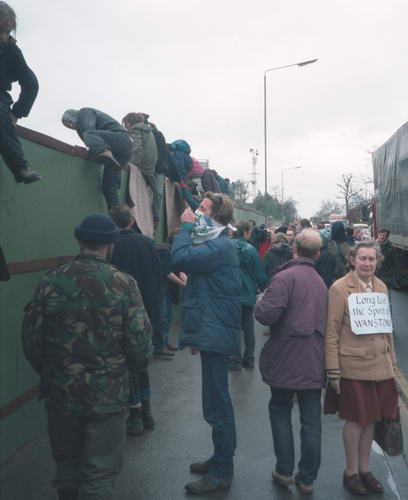
On the outside of destruction site fences
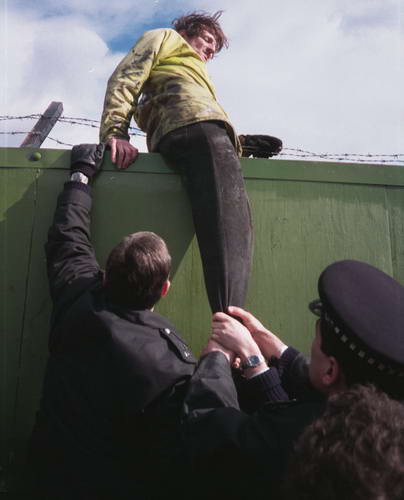
Ouch! Roger wasn't quick enough getting over

Inside the fence
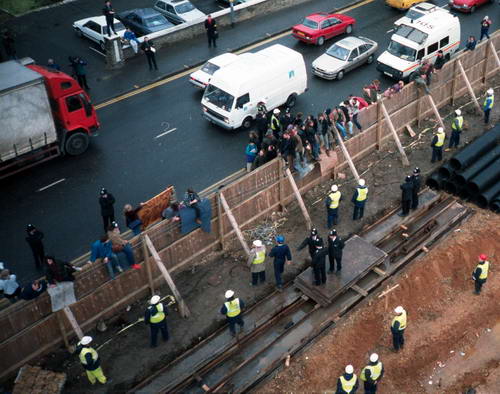
Sitting on the fence waiting for a gap in the cops and guards
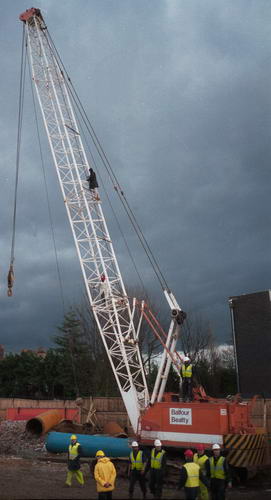
One person was all it took to stop a machine

Though often we sought safety in numbers

Deliberately dragged through the mud

Locked on to a digger by her neck with a bike D lock

Arrogant bastard. Transport minister McGregor pretending everything is normal
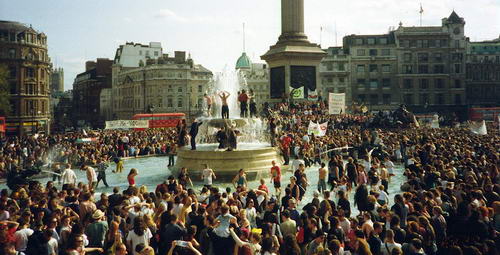
First CJB protest was held on Mayday
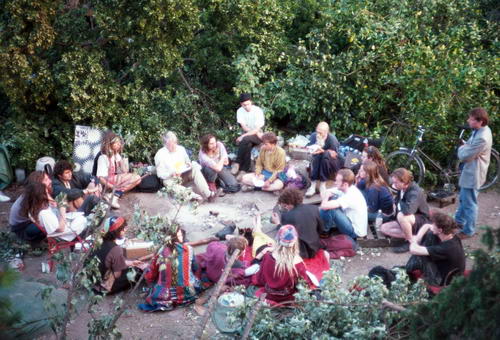
Meeting in the partially trashed bender site

Cafe at the indepenedent free state of Euphoria
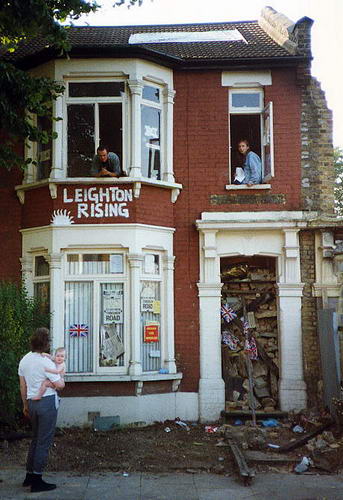
Lifelong home of Richard Leighton re-occupied by protesters
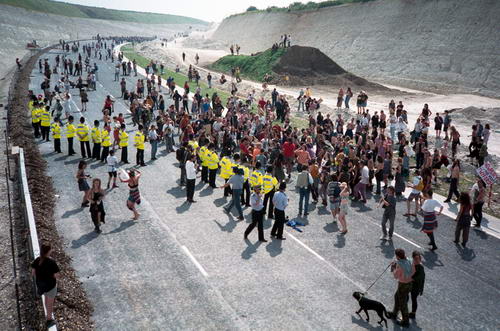
Requiem for a landscape protest. The cutting through Twyford Down
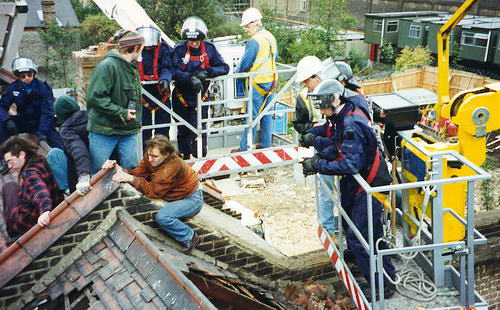
Siege of Euphoria in progress

Snatched from the roof in an undignified manner
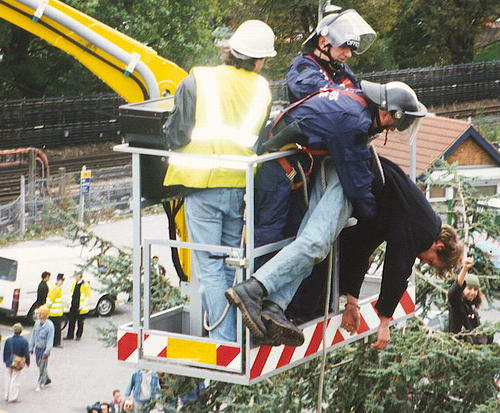
But this tactic was potentially lethal

Concrete filled oil drum lockon
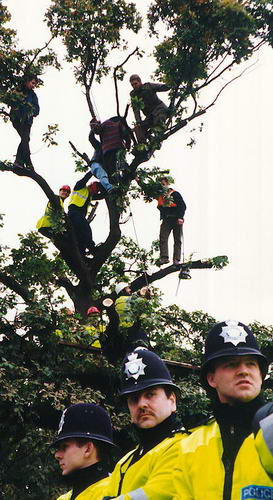
Treetop eviction outside Euphoria
 http://www.indymedia.org.uk/en/2004/02/285484.html
http://www.indymedia.org.uk/en/2004/02/285484.html Following the siege and demolition of Wanstonia, the M11 campaign was without an office, as, having been located in Wanstonia in number 12, it too had been demolished. Fortunately as a result of all the media coverage, there were significant funds coming in to the campaign from supporters all over the country and so we rented a railway arch off Grove Green Road in Leyontonstone. It was during meetings here that we decided that for the next part of the campaign, we wouldn't passively wait for the next house demolitions to be carried out by the thugs hired by the Department of Transport. All of us were absolutely determined to stop this iniquitous road scheme from progressing further and we wanted the campaign to be much more proactive.
Some of us had read about and been tremendously inspired by the Franklin River blockade in Tasmania. This was a massive and completely successful Non Violent Direct Action campaign against an ecologically disastrous plan to dam a river. The Franklin River campaign had received huge coverage on Tasmanian TV and as a result, thousands of people had pledged to take part in a continuous daily rota of blockading. Our ambition was to create something similar with such a sustained level of protests that no destruction work could take place for an entire month. For several weeks we flyposted and networked massively with other activist groups from all around the country. We asked them to pledge support for our campaign and book several days at a time when they’d be prepared to join us and take part in the protests.
There was still hardly any alternative media in those days. Undercurrents were just starting up that same year. Their video clips were excellent but by the time undercurrent’s videos had been edited, duplicated on VHS and sold, the contents could be months old. We had continued to improve our links to the mainstream media. We saw this as vital, not just as a way of attracting new support for the campaign, but also so as to continually pile on to the embarrassment effect being experienced by the government with their idiotic 23 billion pound road spending program. Anti-roads protests were now starting to happen in other parts of the country at Solsbury Hill - near Bath and Preston and the government couldn't just ignore them as their coverage was being splashed across TV screens and newspaper front pages on a regular basis.
Two skipped 286 computers running Windows 3.1 had been added to our frantically busy office. Fax modems had only very recently become available and we added a newly bought modem to one of these PCs. By today’s standards it was absurdly expensive at over £180 but it turned out to be a really worthwhile investment that enabled us to achieve more and more widespread media coverage. By just clicking a few buttons on the computer, we were able to leave it unattended faxing out our press releases to dozens of newsrooms during the evening, while we relaxed in the pub. One of our volunteers also worked at Greenpeace and she said they had nothing as sophisticated as that. They still relied on a volunteer pushing a bit of paper repeatedly through a fax machine and manually dialling the numbers for hours on end.
In their usual secretive manner, the police had always used code words to name their large-scale operations. Their siege of Wanstonia had been called "Operation Barnard". So for our epic planned campaign of direct action we came up with "Operation Roadblock". The name did lack a little of the imagination of the names of previous actions. For instance when the police had staged "Operation Market Garden" at Twyford Down we had organised the amazing "Operation Greenfly" as a direct response. But the name Roadblock sounded grand and in-your-face so we stuck with it.
The kick off date for Operation Roadblock was set for March 15'th - the Ides of March. In the run up to it, we sent out ominous press releases warning the DoT and their contractors to "Beware the Ides of March!” The whole build up to Roadblock was immense. We would have looked very foolish if no one had turned up, so it was a great relief that plenty of enthusiastic supporters did appear on the very first day. The volunteers who had travelled here from all over the country congregated in one of the many squatted houses in Fillebrook Road. Here we served them breakfast followed by legal briefings, instruction in non-violent direct action and then exercises in fence climbing - all of this in front of TV cameras, which in those days we didn’t mind inviting in.
After all this preparation, we led everyone in a merry but decidedly nervous throng to the outside of the destruction sites ready to do battle with the forces of darkness. For a touch of surrealism, many protesters were dressed as lollipop ladies and men in white coats carrying lollipops bearing comical "Stop" themed slogans. We threw zebra crossing painted carpets over the barbed wire fences, stormed over and danced on the machinery inside. The first day had been relatively easy. The cops pretty much stood back and let us have our day in front of the rows of journalists who were present. Destruction work was stopped to much cheering.
On subsequent days when fewer journalists were around, the cops made things much harder and scarier. The whole protest was incredibly, unrelentingly full on. More so at this stage of the campaign than at any other time and it was extraordinary how courageous and committed people were. We had to dodge all the police running up and down the outside of the fences surrounding the destruction sites. We had to very rapidly climb the eight-foot high smooth wooden fences topped with barbed wire. If you were too slow then the cops would grab you by the ankles and be quite likely to roughly pull you down, not caring if you fell on your face or if you became snagged on the barbed wire. On the inside of the fence you’d be facing a line of security guards, some of them known to be violent. You’d wait sitting on top of the fence until the guards nearest to you were distracted chasing someone else. Then you’d have to jump down eight feet and sprint at incredible speed hotly pursued by security guards, zigzagging through mud, leaping over piles of rubble and building materials and then scramble onto any of the machinery operating inside.
Once you were on the machinery, it was best to climb to the highest and most inaccessible part to avoid the grasping hands of security guards. The more hardcore activists would use a bicycle D lock to lock themselves by the neck to some part of the machine. It could then take hours for heavy duty cutters to be used to free them. To my mind, the best machines to go for were the very tall pile sinking cranes. The view right from the top of the derrick was always spectacular though somewhat depressing as you could see the linear swathe of destruction stretching out in both directions. Once any person was on any of the machines, the driver would then have to stop the engine. Machinery stopped = destruction stopped = Result! Huge relief. It was usual to stay up on a crane until knocking off time when we'd all troop out along with the rest of the workers. One time though when a critical concrete pour had been disrupted, protesters had sleeping bags and food supplies brought in by special delivery so they could spend the night up cranes.
By having enough protesters repeatedly stopping work in this way on a daily basis for an entire month we hoped that Norwest Holst - the contractors for this section of the motorway would find it impossible to continue, maybe even go bankrupt. Some of us used to subscribe to New Civil Engineer and Construction News magazines so we knew that they were already in financial difficulties. Certainly the security costs for the project were spiralling higher and higher.
After a day of exhausting digger diving, John the cook would serve everyone an amazing meal cooked up from vegetables retrieved from supermarket skips and street market refuse. In this way we were able to run the campaign on a shoestring budget. Nearly everyone performed multiple roles and so the cook would also come on site invasions with the rest of us. We were always a little worried by this as if he was arrested, then we knew that we’d eat very badly that night as no one else was anything like as skilled as him. Finding sleeping accommodation for so many extra people was never a problem. At Twyford Down, the only accommodation had been in benders and tents so that during winter, when everything was a sea of mud, life for the protesters there had been desperately hard. For the M11 campaign however accommodation was very much easier. Over 300 houses were due to be demolished and so there were always plenty of condemned houses that we re-occupied, squatted and refurbished at every opportunity and made available for everyone that turned up.
On some days the main destruction site would be so saturated with cops and security guards that it’d be unfeasible for us to stop work on that site. So we’d all suddenly disappear down onto the tube & suddenly reappear at the less well defended Temple Mills site much further down the line of the route where we’d have little problem stopping work. Decisions like this were usually made on the spur of the moment and this was how we managed to stay one step ahead of the forces of darkness. People used to admire us, thinking that we must all be brilliant planning strategists. We certainly had people like that amongst us but the reality was that much of the time, decisions were made in a chaotic manner. That was our strength though, as the outcome of chaos is very hard to predict for highly structured organisations like government and the police. We lived and learned, continually gaining experience. During early days we discovered that just a few of us could build up a rhythm by pushing the eight-foot fence panels to and fro until they broke and collapsed in a very satisfying way. Contractors then added horizontal steel reinforcing bands along the outside and we soon found that these could be tugged out in a loop to make a handy step with which to climb up the fence from the outside. Similarly, diagonal bracing bars were added on the inside that then made it easier for us to climb down there.
In those pre-criminal justice act days, it wasn’t technically a criminal act to invade a work site and attempt to stop the destruction. It was simply a case of civil trespass and all that the dozens of security guards had to do was use “reasonable force” to eject any of us that they caught. Some of the sadistic guards used to delight in dragging us through as much mud as possible on the way to the gate. We were also photographed by men who were believed to be private detectives. Lawyers working for the DoT were trying to identify each of us in order to compile a list of “ringleaders” to serve injunctions on. The police would often remove persistent site invaders for the day by arresting them and charging them with breach of the peace. One of our guys was arrested 7 times in 14 days. We kept a list of all those arrested pinned to the wall in the office but when the bottom of the list started to drag on the floor numbering over 300 we gave up keeping tally. About a dozen people, nearly all of whom had made named appearances on the media and were therefore deemed to be “ringleaders” did eventually have injunctions served on them, ordering them to stay well away from the sites. This seemed to have negligible effect on the campaign though as there were so many hundreds of us involved. They would have had to collect evidence on and identify each and every one of us in order to serve sufficient injunctions to stop the protests.
It was as a direct result of this level and style of protest that the government started drafting new laws to criminalise dissent under the Criminal Justice Bill. This was a whole raft of deeply iniquitous laws drawn up for Michael Howard the home secretary that criminalised the lifestyles of ravers, hunt saboteurs, squatters, travellers and anyone engaging in direct action protest. The most significant clause of this new bill that was to affect road protesters was the new catch-all offence of aggravated trespass that made it a criminal offence for anyone to “disrupt any lawful activity”. The lawful activities included destroying communities, people's homes, ancient monuments, priceless landscapes, the environment and killing foxes.
The result of this new common threat on all these disparate groups was to bring them together and so new links were forged between us. Huge joint protest marches were held in the centre of London during the summer and lawyers and even lords spoke out against these unjust new laws that were clearly designed to outlaw protest itself.
Despite all the media interest brought about by the almost continuous protests, we were frustrated that those at the top who were really pulling the strings just weren’t hearing our message sufficiently loudly. One of our boldest and most imaginative actions was when we hired a long ladder and, very early one morning, 9 protesters used it to climb onto the roof of John McGregor, the transport minister’s house in Muswell Hill. From there a huge mock motorway banner was hung down the front of his house so as to cover the windows.
The police arrived within minutes looking very flustered. Maybe they thought we were terrorists intent on kidnapping a cabinet minister. They were hotly followed by all the media who were intrigued to see a senior government figure under physical siege in his own home. By making the protest this personal, we hoped McGregor would be forced to think about just what it must be like to have your home invaded and a road built right over it. Reports circulating at the time said that McGregor’s wife had been terrified on waking up and finding the windows covered over. This of course was very tame stuff compared to what the people living in Leyton and Leytonstone were experiencing on a daily basis. Vicious bailiffs would arrive early in the morning, batter down doors of condemned houses and dump families and all their possessions onto the pavement. To prevent squatters like us from re-occupying the house, a thoroughly evil firm of demolition thugs would often trash the roof and the insides of the house within hours. Sometimes they’d even demolish houses with people’s belongings still inside.
Fortunately, the case brought against the McGregor 9 collapsed in court. No damage had been caused to the house and because McGregor’s wife was not prepared to testify in court that she had been terrified, there was no evidence to proceed with. In fact McGregor did seek revenge when he later wined and dined a Sunday Times journalist who then wrote a demolition piece about road protesters claiming that we were violent etc. This was to mark a gradual turning point from the significantly positive coverage that we’d received until then.
Eventually, Roadblock became unsustainable. While the government seemed prepared to spend unlimited amounts of money on employing more and more police and security guards to protect the sites, it became harder and harder for us to maintain correspondingly adequate numbers on our daily rota. For many of those involved, the M11 campaign had taken over their entire lives. After an exhausting day storming around the destruction sites, many people would have to spend the evenings barricading their houses or return to the campaign office and stay up into the small hours either planning future actions or pounding out press releases or leaflets on the creaky computer. Working 36 hours at a stretch was not uncommon. As at nearly all road protest sites, defending a long linear route proved to be very difficult. While all the site invasions had been going on near Wanstead, there were few people available to defend all the threatened houses further down the route in Leyton and Leytonstone. Houses were being seized by baliffs, often illegally, and demolished on a daily basis and this caused some resentment that so much energy was being directed into attacking barren work sites when people’s beloved homes were being trashed at a faster rate than ever.
The campaign was lasting longer than any of us had predicted. By comparison, the protests at Twyford Down had ceased to be effective after only a few short months. The M11 protest had become no longer just about the government's inept transport policy. Spontaneously, a whole host of other social issues had been taken on board. The housing shortage, homelessness, poverty, social exclusion, police brutality, squatters rights, travellers rights, indigenous people's rights. We staged support protests and made links around the world with other groups such as the villagers in India whose homes were being drowned under the rising waters behind the Narmada dam. We also received many messages of support ourselves from people similarly threatened by callous development projects. By far the most affecting was a letter from indigenous Amazon tribes people who were constantly under attack from murderous loggers. They hoped that during our similar struggle, not too many of us had been killed.
Richard Leighton had been born and lived with his elderly mother in a house in Colville Road that was directly in the path of the M11 link road. He had been campaigning against the link road for decades and had refused to accept the compulsory purchase of his home. The bailiffs battered his door down early one morning and the shock to his mother was so great that she collapsed and had to be taken away by ambulance. Protesters triumphantly re-occupied his house shortly afterwards. This sort of event was a public relations disaster for the Department of Transport. They tried to justify their indefensible actions, but more and more of the public at large were now seeing them as completely brutish and uncaring. It was highly significant that the government slashed a third off the road building program later in the year.
All through the summer, trees were occupied, groups of houses and land continued to be squatted, barricaded and transformed by us; fought over in the high court... and then duly evicted and demolished. Leytonstonia - the bender site, set in a hidden corner of trees just off Fillebrook Road. Also in Fillebrook Road, the independent free state of Euphoria was created, a wonderfully laid back cafe.
One scorching summer’s day we cycled down to Hampshire to join up with thousands of others taking part in Requiem for a Landscape. This was to be the final protest at Twyford Down. We were all shocked and saddened to see how a former Area of Outstanding Natural Beauty had been so desecrated by the M3 motorway slicing through it, since protests there had ended the year before.
Eventually we lapsed back into a more defensive mode. Over the passing months, we were gradually forced to retreat bit by bit to the condemned Claremont Road. This was to become a legendary stronghold; a magnet for artists, photographers, social commentators and journalists and the grand finale of the campaign. We spent the whole of the summer and autumn furiously barricading the houses there against the epic, record breaking eviction that was to come on budget day.
More on this on the anniversary of the Claremont Road eviction in November.
kriptick
Comments
Display the following 15 comments